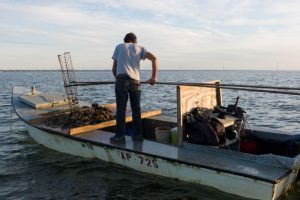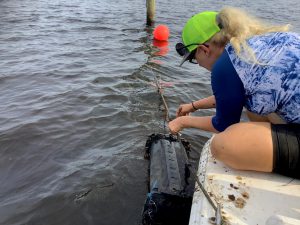
Folks started bragging to me about East Bay oysters as soon as I set foot in Pensacola decades ago. While the world knows Apalachicola oysters, their salty cousins to the west were a bit of a locals’ secret. My husband’s family has owned land on East Bay since the 1930’s, and as a kid he would go out tonging for oysters with his dad. Big family gatherings always included very local seafood; mullet from the cast net, blue crabs from traps on the dock, and oysters gathered from the bay. Even as toddlers, his younger brothers would slurp down raw oysters as fast as folks could shuck them.
Thousands of northwest Floridians share similar memories, and when the wild oyster populations started really declining over the past 15-20 years, a collective sense of loss and mourning surrounded discussions of the oyster. A combination of rapid population growth, declining water quality, heavy rains (causing a drop in salinity), and overharvesting (particularly just before the oil spill impacts washed in) caused the annual oyster harvest from here to Apalachicola to plunge.

Over the past few years, a new industry has proliferated locally to address these losses. At least a half dozen small oyster aquaculture businesses have started up, seeking to reclaim the glory days of the East Bay oyster. Florida law allows growers to obtain leases over open stretches of bay in shellfish-approved waters. Leases may be as small as an acre or spread over hundreds of acres. They are generally denoted by 4 tall pilings set up in square corners around the lease, with large yellow caution signs. Between these posts, farmers either secure baskets to the bay bottom or attach rows of hanging baskets along rope that dangles in the water column. The baskets are full of oyster “seed”—young oyster larvae no larger than your fingernail. Over the span of nine months to a year, those young oysters feed in the bay, growing in the relative safety of the baskets. At harvest time, the in-demand oysters can be sold in local markets and even online.

Several of these farmers have gathered to form the Gulf Coast Seafood Cluster, which is a collaboration of aquaculture farmers working together. One component of this effort is a “micro-hatchery” started by the Florida Oyster Trading Company. They produce microscopic oyster spawn and grow larval oysters up to a size large enough for the oyster farmers to safely place in the grow-out baskets. The larval oysters are raised in water drawn from East Bay, so their entire life cycle is within local waters.

Farming, whether on land or in the water, is never an easy prospect. Aquaculture farms are at the mercy of weather and hurricanes, wayward boaters, thieves, and marine predators. When you see local oysters on the market this fall and winter, be sure to try them out and support the revival of this iconic—and delicious—local fishery.
For more information on the history, status, and plans for revitalizing oysters in the region, check out the recently completed Oyster Fisheries and Habitat Management Plan for the Pensacola Bay System.
 1
1
